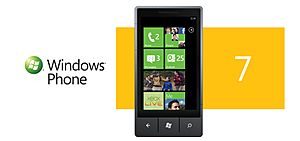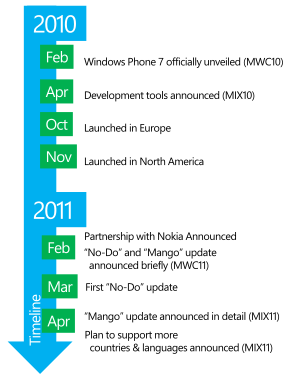Windows Phone 7 facts for kids
 |
|
| Developer | Microsoft Corporation |
|---|---|
| OS family | Windows Phone |
| Released to manufacturing |
November 8, 2010 |
| Latest release | Windows Phone 7.8 (Build 7.10.8862.144) / March 13, 2013; 7 years ago |
| Repository |
|
| Update method | Zune Softwares |
| Platforms | 32-bit ARM architecture |
| Support status | |
| Unsupported as for September 9, 2014 | |
Windows Phone 7 was the very first version of the Windows Phone mobile operating system. It was created by Microsoft and first released on November 8, 2010. This system ran on a special core called the Windows CE 6.0 kernel.
Windows Phone 7 looked a bit like Windows 7, which was a computer operating system. It received updates from Microsoft, with the last one being Windows Phone 7.8, released in March 2013. Some features from Windows Phone 8, like a more customizable start screen, were added to Windows Phone 7.8. The next version after Windows Phone 7 was Windows Phone 8, which came out in 2012.
Contents
History of Windows Phone 7
Microsoft first showed off its new mobile operating system, then called Windows Phone 7 Series, on February 15, 2010, at an event in Barcelona. They shared more details later that year. The tools developers needed to create apps for it, called the SDK (Software Development Kit), were ready by September 16, 2010. The name was later shortened to Windows Phone 7 on April 2, 2010.
On October 11, 2010, Microsoft's CEO, Steve Ballmer, announced ten new phones that would use Windows Phone 7. These phones were made by companies like HTC, Samsung, Dell, and LG. Sales started in Europe and Australia on October 21, 2010. For the United States, Windows Phone 7 phones were released on November 8, 2010.
These new phones were available through 60 different phone companies in 30 countries. More devices were planned for 2011. Microsoft also released major updates for Windows Phone 7, known as "Mango" and "Tango," which added new features and supported more languages in the Windows Phone Store.
Key Features
How it Works
Windows Phone 7 was unique because it was the only version of Windows Phone that used the Windows CE 6.0 kernel. This kernel was also used in older systems like Pocket PC and Windows Mobile.
User Interface and Live Tiles
Windows Phone 7 had a special look called "Metro." The main screen, known as the Start screen, was made up of Live Tiles. These tiles were like shortcuts to apps, features, or even specific contacts. You could add, move, or remove these tiles.
What made Live Tiles cool was that they were dynamic. This means they could update in real-time. For example, a tile for your email might show how many new messages you have, or a weather tile could show the current temperature.
Many features in Windows Phone 7 were grouped into hubs. These hubs brought together information from your phone and from online services. For instance, the Pictures hub showed photos you took and pictures from your Facebook or Windows Live accounts. The People hub combined contacts from different places like Facebook and Twitter.
Hardware Requirements
When Windows Phone 7 first came out, phones had to meet certain requirements. They needed to use a specific type of processor (32-bit ARM architecture). Companies like Samsung, HTC, Dell, and LG made these phones.
Initially, Windows Phone 7 devices needed at least 256MB of RAM (memory). However, for the "Mango" and "Tango" updates, these requirements were changed. This allowed phones with slower processors and as little as 256MB of RAM to run the system. Some features and certain apps needed more RAM, so many phones still had 512MB of RAM, especially for the "Tango" update.
All Windows Phone 7 devices had to have a special Search button on the front. This button could do different things depending on what you were doing on the phone. For example, if you were in your contacts, pressing Search would let you look for a specific person. Later, this button was mainly used for the Bing search engine.
Windows Phone also had a voice recognition feature, powered by TellMe. You could use your voice to search with Bing, call contacts, or open apps. You activated this by holding down the phone's Start button.
Software and Apps
Zune Software
To manage and transfer content like music and videos between your Windows Phone 7 device and a computer, you used Zune software. This software also let you buy music, videos, and apps from the Zune Marketplace. While music and videos were stored on both your computer and phone, apps were only stored on the phone. Zune software was also used to deliver system updates to Windows Phone 7 devices.
For Mac computers, Microsoft released "Windows Phone Connector" to help sync with iTunes and iPhoto. This was later replaced by the "Windows Phone App."
Music and Videos
The Music + Videos hub was where you could find all your music, videos, and podcasts stored on your phone. It also connected directly to the Xbox Music Store, where you could buy music or rent it with a subscription. This hub worked with other apps like YouTube and Vevo.
Pictures
The Pictures hub showed photos taken with your phone's camera. It also connected to your Facebook and SkyDrive (now OneDrive) photo albums. You could upload photos to social networks, comment on friends' pictures, and tag people in photos. You could zoom in and out of pictures using multi-touch gestures.
Office Apps
The Office hub organized all your Microsoft Office apps and documents. With Microsoft Office Mobile, you could view and edit most Microsoft Office files, like Word, Excel, PowerPoint, and OneNote, directly on your Windows Phone device.
You could open files from cloud services like SkyDrive and Office 365, or files saved on your phone. Office files were shown with different colored tiles: blue for Word, green for Excel, red for PowerPoint, and purple for OneNote.
Contacts and Social Media
Your contacts were organized in the People hub. You could add contacts manually or import them from services like Facebook, Windows Live, Twitter, LinkedIn, and Gmail. The "What's New" section showed updates from your friends' social media, and the "Pictures" section showed their photos.
A "Me" section let you update your own social media status. If a contact had information on different networks, you could link their accounts together to see all their details in one place. In Windows Phone 7.5, you could also group contacts together.
Version History
Windows Phone 7.5 (Mango)
Windows Phone 7.5, also known as "Mango," was a major update released in 2011. This version brought many improvements, including new features for Live Tiles and better support for apps.
Windows Phone 7.8
Windows Phone 7.8 was the final update for Windows Phone 7, released on March 13, 2013. This update brought some features from Windows Phone 8 to older devices, especially a more customizable Start screen. Microsoft continued to support Windows Phone 7 devices from Samsung, Dell, and HTC until September 9, 2014.
Features Added in Later Windows Phone Versions
Features in Windows Phone 8
Some features that were not in Windows Phone 7 but came later in Windows Phone 8 include:
- Using removable SD cards for storage.
- Transferring files using USB.
- Sending files via Bluetooth.
- Connecting to Wi-Fi networks with hidden names and strong security.
- Installing company apps directly without the app store.
- Video calls built into the phone app.
- Better security for Office documents.
- Encrypting data on the phone.
- Using strong passwords.
- Full support for Exchange email.
- Running apps in the background.
Features in Windows Phone 8.1
Even more features were added in Windows Phone 8.1, such as:
- VPN security for private network connections.
- A file manager to organize files on your phone.
- A "Weekly" view in the Calendar app.
- A search that looks everywhere on your phone.
- Video calls over mobile networks.
Images for kids
Related pages
See also
 In Spanish: Windows Phone 7 para niños
In Spanish: Windows Phone 7 para niños






